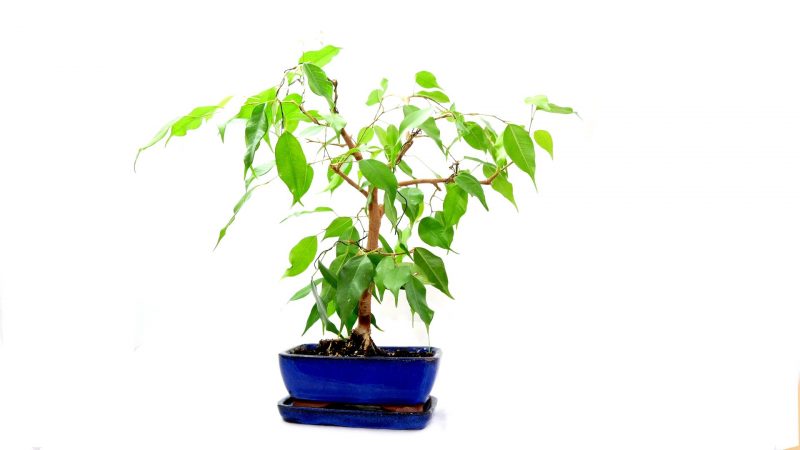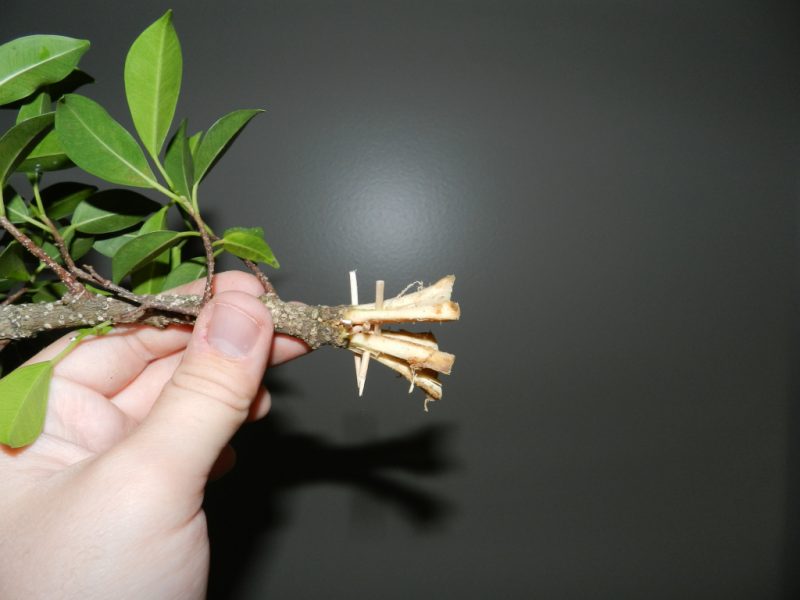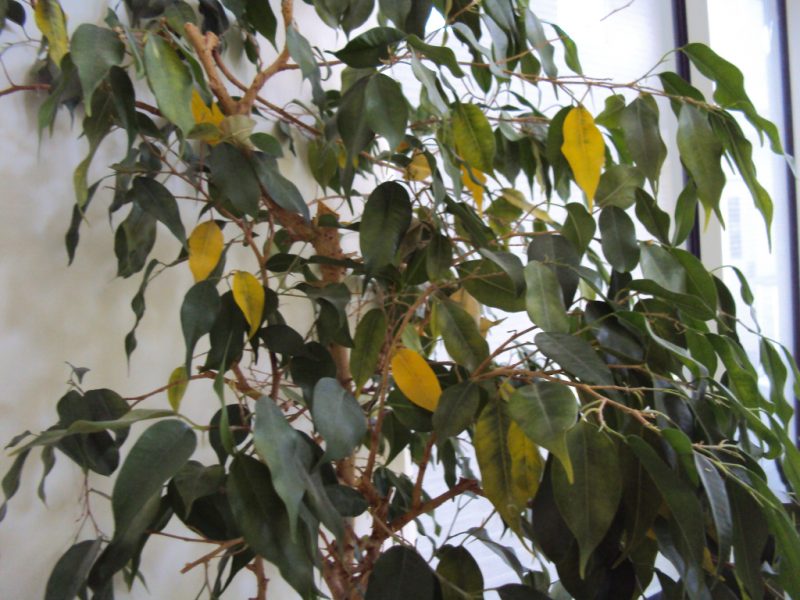Ficus is a beautiful ornamental plant with dark green leathery leaves. In indoor conditions, most often one of its varieties is grown - Benjamin's ficus. This flower loved by many does not require too much attention, but needs some care. Meanwhile, not everyone is wondering how to care for ficus at home correctly, while it makes some demands on the conditions of “living”.
Material Content:
Ficus: the nuances of growing
Ficus Benjamin is extremely demanding on the place of growth. It should not only satisfy his needs for lighting, humidity and temperature conditions, but also remain constant, since this species does not like a change of scenery. Do not unnecessarily move it to another window and rotate in order to align the crown.

Therefore, pre-worry about the choice of place, so that later you do not accidentally ruin an adult plant.
How to care for ficus at home?
Caring for this houseplant is not too difficult. But this is not as simple as in the case of some other plants. Florists usually have to solve the difficult dilemma of how to simultaneously provide high temperature and humidity, because usually the hotter the drier the air.
Temperature features, lighting, humidity

Some features of ficus care:
- Unlike most houseplants, who do not like excessive heat in summer, the ficus flower grows well at 25-30 degrees.In winter, he prefers light coolness in the region of 16-20 degrees, for which even placement on the windowsill may be sufficient. However, it is not recommended to allow temperature drops to +14, since it is not suitable for a colder environment.
- Despite the thermophilic, the plant prefers high humidity. To moisturize, you can use containers with water, placed around the tree, growing moss and spraying. You need to spray it in the morning or in the evening with the expectation that at the height of the day there will be no drops on the leaves. In a person suffering from dry air, the plants turn yellow and the leaves fall.
- The flower is critical to humidity even in the winter, therefore warm wintering is contraindicated.
- Ficus loves sunlight, preferably bright but diffused. We must not allow the direct rays of the midday sun to fall on the leaves, so often the pots are placed on the eastern or western windows. If there is no choice, then you can arrange for him to shade at noon by means of a mesh curtain or half-closed blinds.
- It is not worth turning the flower to uniformly form the crown. But if you really want to, you can do this infrequently by moving the pot 15-30 degrees at a time.
- Variegated varieties of ficus require enhanced lighting, since the area of the green surface of the leaves, where photosynthesis is possible, is small. Varieties with ordinary leaves prefer diffused light, although it is better not to put them on the northern windows. The best option is orientation to the east or west.
Soil requirements
The flower grows well in universal purchased soils for indoor plants, to which ordinary soil from a vegetable garden, garden or forest is added. Experienced gardeners can make up a soil mixture of equal parts of turf, foliage, peat and coarse sand.
Watering and feeding
Watering the ficus is carried out as necessary, when the drying of an earthen coma is observed.

Its roots do not tolerate too cold water, so the water collected from the tap is infused at room temperature.
- This plant is at risk for rotting the root system, so it can not be transfused. For this reason, they plant it in pots with good drainage and a mandatory drainage hole.
- They usually fertilize every 2-3 months, from March to September, with complex fertilizers for indoor plants. You can also bring a solution of mineral fertilizers by adding approximately equal amounts of nitrogen, phosphorus, and potassium to the water.
Cropping and cutting crown
Like any tree-like houseplant, ficus needs the formation of a crown. This is done, firstly, for aesthetic reasons, and secondly, in order to prevent excessive stretching of the tree.

Usually, using this procedure, they try to form a tree with 3-5 skeletal branches (in addition to the main trunk). All manipulations with secateurs are subordinate to this goal.
Pruning is done in spring or late winter.
- In a young annual plant with only one stem, pruning is performed at about 50-70% of its height. Soon he launches lateral shoots, from which 3-5 are chosen, which later become skeletal branches.
- A perennial tree is examined before pruning, fatty shoots are calculated, which take away too many forces and spoil the appearance of the tree, and either remove them completely or cut them in half.
- Also shoots growing inside the crown or thickening it are removed. Naturally, damaged, withered and weak branches are also cut.
Plant transplant
On average, young ficuses require a pot change annually, but this can be done more often if the need arises. Adult plants need less transplantation. And the criterion for this can be only one: the root system filled the earthen lump, which is usually visible through the drainage hole, if it is wide enough.

There are only three basic rules:
- the new tank should be 2-4 cm larger than the old one;
- the drainage layer at the bottom should be sufficient;
- When transshipment, an earthen lump should not be shaken off.
Ficus propagation
The only available method of propagating ficus for home gardeners is cuttings.

Fortunately, cuttings are easily rooted even in water when they are cut correctly.
A little faster, this process takes place in wet coarse sand or light peat-based soil.
Reproduction Stages:
- A semi-lignified stem with 4-6 leaves is cut, half of which (those closer to the lower cut) is immediately removed.
- The slice is leveled with a sharp blade and washed with milky juice, after which the twig is planted either in the ground or lowered into the water.
- To increase the chances of success, the stalk is covered with a plastic bag or a mini-greenhouse made of transparent plastic.
- The roots appear in a month. A week later, when their length reaches 2-3 cm, the young seedling can be moved to the pot.
Important! Too fresh green cuttings root badly!
Pests and diseases - how to treat?
Ficuses are ill and suffer from pests rarely and only with improper care.

It is susceptible to certain diseases and pests:
- fungi;
- assault attacks;
- thrips;
- mealybug;
- aphids;
- spider mite.
All of the above pests are easily eliminated by any insecticides that are used according to the instructions. Against the spider mite, the Fitoverm insect-acaricide is used. If the tick did not have time to take a firm fancy to the plant, then the drug can be bred according to the instructions, but with a serious damage to the tree with a tick, you can exceed the recommended concentration up to two times and produce not one, but 2-3 treatments with a weekly interval.
Of the fungal infections that can affect the flower, gray rot and soot fungus are isolated. They are determined by abnormal spots on the leaves of gray and black colors, respectively. To cure a green pet, “Fitosporin”, copper sulfate and other fungicides are used. Be sure to in such cases, you need to identify the cause of the weakening of the natural immunity of the ficus. Usually this is due to inappropriate conditions of detention, because a well-groomed and strong plant is able to resist pathogenic fungi.
What problems can a flower grower face?

Most often, lovers of indoor plants have to deal with such problems:
- Falling leaves, which can be caused by both natural conditions and errors in care. At the end of autumn or during the winter, the loss of a small amount of the old lower leaves is normal. If the leaves turn yellow and fall off en masse, this indicates too low air humidity. The optimum humidity for it is 70%, the minimum allowable is 50%.
- The slow growth of the plant, the reason for which usually lies in the lack of nutrients in the soil due to the fact that the roots have fully mastered the earthen lump. In such cases, transplantation into larger pots is recommended, as well as top dressing, which should be done no earlier than a month after the transplant.
- Fungal diseases resulting from a weakened plant immunity.
Important! If the ficus is recently acquired or rearranged, then it can not be transplanted earlier than a month later. These plants really do not like changing the place of growth, so he should be given the opportunity to get comfortable in new conditions.
As you can see, growing ficus is not the most difficult task. If you provide him with sufficient humidity and the desired temperature, then, in general, it does not cause trouble. Should I take this tree? This is a personal matter for everyone. And as life shows, almost every enthusiastic grower gives a positive answer to this question: yes, it’s worth it!












